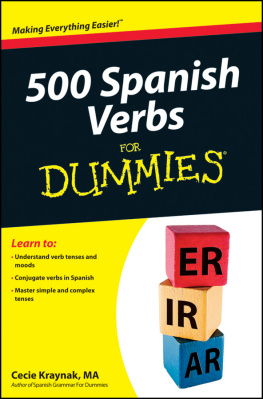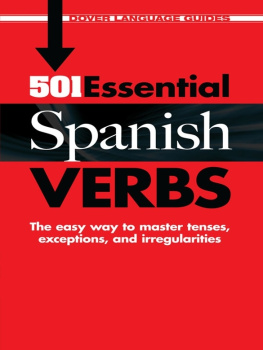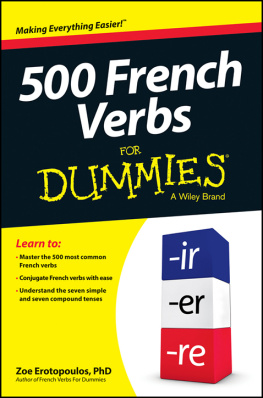Essential
Italian
VERBS

Essential
Italian
VERBS
L OREDANA A NDERSON - T IRRO
DOVER PUBLICATIONS, INC.
Mineola, New York
Copyright
Copyright 2011 by Loredana Anderson-Tirro
All rights reserved.
Bibliographical Note
501 Essential Italian Verbs is a new work, first published
by Dover Publications, Inc., in 2011.
Library of Congress Cataloging-in-Publication Data
Anderson-Tirro, Loredana.
501 essential Italian verbs / Loredana Anderson-Tirro.
p. cm. (Dover language guides)
Text in English and Italian.
Includes bibliographical references and index.
ISBN-13: 978-0-486-47627-8 (alk. paper)
ISBN-10: 0-486-47627-8 (alk. paper)
1. Italian languageVerb. 2. Italian languageGrammar. 3. Italian
languageTextbooks for foreign speakersEnglish. I. Title.
PC1271.A53 2011
458.2421dc23
2011020492
Manufactured in the United States by Courier Corporation
47627801
www.doverpublications.com
Many students of Italian have struggled with the correct usage of Italian verbs. One need only think of the subjunctive tenses, the present perfect (passato prossimo) and past absolute (passato remoto) vs. the imperfect (imperfetto), to want to throw ones hands up in despair. This text aims to rectify the difficulty of these moments with a simple, straightforward presentation of Italian verbs, in the hope that those moments become a memory of the past.
501 Essential Italian Verbs is a comprehensive guide to verbs and their conjugations. The aim of this text is to provide beginning speakers with a self-learning tool, and more proficient speakers with a reference guide. It is organized into three major sections, an introduction, an alphabetical listing of verbs and, lastly, quick reference guides for fast consultation.
The introduction presents helpful facts to assist readers in the correct usage of verbs, subject pronouns, reflexive, direct and indirect object pronouns, an explanation of the usage of the present perfect/past absolute vs. the imperfect tenses, non-active verb forms, negatives and the indicative vs. the subjunctive tenses. Beginners will also find a pronunciation guide to aid in accurate verb pronunciation. To practice verb conjugations and test comprehension there is a brief verb-practice section.
The introduction is followed by an alphabetic listing of commonly used Italian verbs. Each verb is completely conjugated and includes three sample sentences at the bottom of the page for contextual reference.
Finally, quick reference guides for verbs, pronouns, and other convenient information have been added for rapid consultation. Italian-English and English-Italian indexes conclude the text.
I would like to thank Rochelle Kronzek of Dover Publications for her patience and constant support while writing this text.
This introduction provides basic information regarding the use of verbs in the Italian language. This includes information about pronouns, the formation of past participles, direct and indirect objects, the present perfect vs. the imperfect tenses and the like.
Subject pronouns in Italian are similar to those used in English, in that they replace the subject of a sentence. Nonetheless, it should be noted that these pronouns are not commonly used, as in Italian the subject is indicated by the verb ending. Subject pronouns are used however when there is ambiguity as to who is performing the action of the verb. For example:
EX: He wants to go to Italy, but she prefers visiting France.
Lui vuole andare in Italia, ma lei preferisce visitare la Francia.
The following is a table of the subject pronouns in Italian:
Singular | Plural |
Io | I | Noi | We |
Tu | You | Voi | You (pl) |
Lui | He | Loro | They |
Lei | She | Loro | They |
Lei1 | You | Loro 2 | You (pl) |
Table Note 1. Lei is the formal way of addressing an individual whom one does not know or who has a social position requiring respect. Parents of friends, doctors, professors and political figures would be individuals one might include in this category. Among young people today the formal address is rarely used.
Table Note 2. Loro is the plural form of LEI and is not commonly used. Should the (formal) occasion warrant it, individuals in this group might include highly-placed political figures (president, prime minister, etc.) and their spouses.
Both LEI and LORO take the third person singular and plural respectively. The context provides the meaning so as not to confuse the listener as to who is being referred to (in order to differentiate between HE, SHE or THEY).
In order to use Italian verbs correctly some mention must be made of the object pronouns which frequently accompany them. These include the direct and indirect object pronouns in addition to the reflexive and reciprocal pronouns. All pronouns are placed before the verb, whether they are simple verbs or compound verbs.
Direct Object
Pronouns | Indirect Object
Pronouns | Reflexive/Reciprocal
Pronouns |
mi | (me) | mi | (to me) | mi | (myself) |
ti | (you) | ti | (to you) | ti | (yourself) |
lo | (him) | gli | (to him) | si | (himself) |
la | (her) | le | (to her) | si | (herself) |
La | (you/formal) | Le | (to you/formal) | si | (yourself/formal) |
ci | (us) | ci | (to us) | ci | (ourselves) |
vi | (you/Pl.) | vi | (to you/pl.) | vi | (yourselves) |
li | they/masc. | gli | (to them/masc.) | si | (themselves) |
le | they/fem. | gli | (to them/fem.) | si | (themselves) |
The direct object pronouns take the place of the direct object (or the noun which receives the action of the verb directly). When using LO, LA, LI, or LE it is necessary to change the ending of the past participle in the compounded tenses. In addition, LO and LA are abbreviated to L before the auxiliary verb AVERE or any verb beginning with a vowel.
EX: | I bought an old, red car. |
Ho comprato una vecchia macchina rossa | (DIRECT OBJECT) |
I bought it. |
L ho comprat a. | (DIRECT OBJECT PRONOUN) |
He saw me walking down the street. |
Ha visto me camminare lungo la strada. | (DIRECT OBJECT) |
Mi ha visto camminare lungo la strada. | (DIRECT OBJECT PRONOUN) |
Indirect object pronouns differ from direct object pronouns in the third person singular and third person plural forms. The indirect object pronouns substitute the indirect objects, or nouns that are preceded by the prepositions A ( to ) or PER ( for ). Indirect object nouns are always people or animals. Unlike the direct object pronouns in compound tenses, the past participle never agree with indirect object pronouns, nor does one use apostrophes before auxiliary verbs. When using compound tense verbs requiring ESSERE as the auxiliary however, one must change the endings.
Next page












